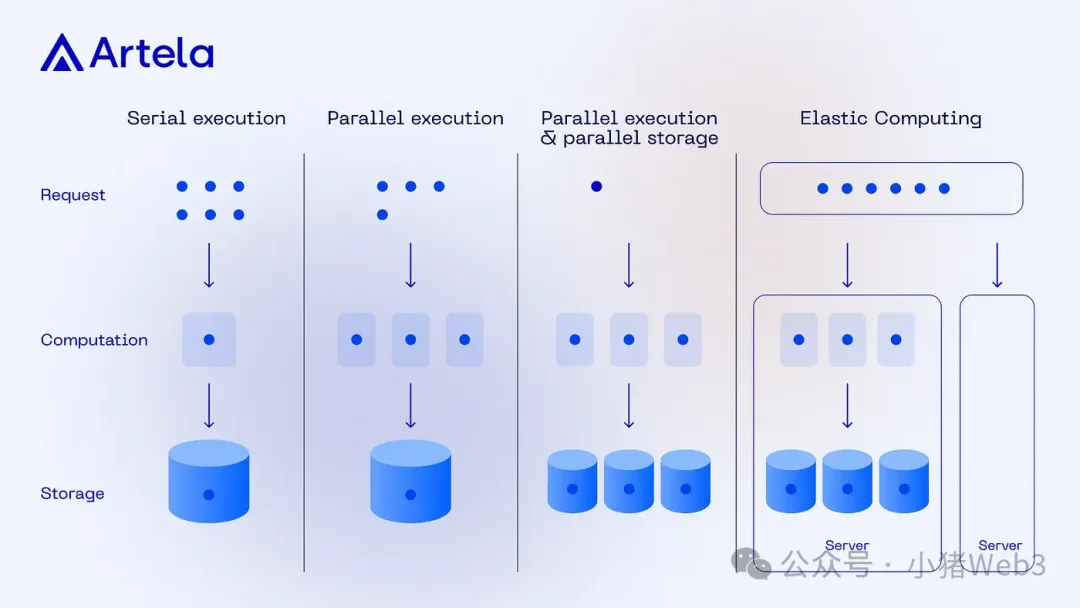Artela Whitepaper
On June 20th, the cutting-edge parallel EVM Layer1 project Artela released the whitepaper "Full Stack Parallelization," aiming to comprehensively unleash the scalability of blockchain and enable DApps to have "predictable performance."

Predictable performance refers to providing DApps with predictable TPS, which is crucial for certain business scenarios. DApps deployed on public chains must compete for blockchain computing power and storage space with other DApps under normal circumstances. Therefore, during network congestion, it will bring relatively high transaction execution costs and transaction latency to business operations, greatly restricting the rapid development of DApps. It can be imagined that if a user is using a decentralized instant messaging software, due to the underlying blockchain network's block space being occupied by other DApps, the user's messages are almost impossible to send and receive, which is a disaster for user experience.
To address the issue of "predictable performance," the most common approach is to use application-specific blockchains, also known as appchains, which are blockchains specifically used for specific applications.
Artela innovatively proposes the solution of Elastic Block Space (EBS), based on the concept of elastic computing, to dynamically adjust block resources based on the specific needs of DApps at the protocol level, providing independent scalable block space for high-demand DApps.
This article will introduce application chains and elastic block space separately and compare the advantages and disadvantages of the two.
Development Path of Application Chains

An application chain is a blockchain created for running a single DApp. Application developers do not build on an existing blockchain but instead build a new blockchain from scratch using a customized virtual machine to execute transactions between users and applications. Developers can also customize different elements of the blockchain network stack—consensus, network, and execution—to meet specific design requirements, thereby addressing issues such as high congestion, high costs, and fixed features on shared networks.
Application chains are not a new concept: Bitcoin can be seen as an application chain for "digital gold," Arweave can be seen as an application chain for permanent storage, and Celestia can be seen as an application chain that provides data availability.
Since 2016, application chains have not only included single blockchains but also multiple chain forms, namely ecosystems built by multiple interconnected blockchains, with the main representatives being Cosmos and Polkadot. Cosmos is the first to envision a world of interconnected blockchains, dedicated to solving the problem of cross-chain interaction in blockchains, and can quickly develop and launch a chain through the Cosmos SDK, designed the IBC protocol for seamless blockchain interaction, etc.; Polkadot aims to be a perfect blockchain scaling solution, with chains in its ecosystem called parallel chains, advocating shared security from the beginning, and different parallel chains can communicate through cross-consensus information.
At the end of 2020, as Ethereum's scaling research focused on sidechains, subnets, and Layer2 Rollups, application chains also incubated corresponding forms. Sidechains such as Polygon, subnets such as Avalanche, all aim to improve the experience and performance of sidechains or subnets to enhance overall service capabilities; Layer2 Rollups, in the form of modular stacks supporting application chains, with OP Stack and Polygon CDK being welcomed by many projects, the goal of Layer2 Rollups solutions is to increase the throughput and scalability of the Ethereum network to meet the growing transaction demand and provide broader interoperability and interconnectivity.

Currently, a large number of applications are built on application chains across various platforms. For example, Axie launched its Ethereum sidechain Ronin in early 2021; DeFi Kingdoms announced its migration from Harmony to the Avalanche subnet at the end of 2021; Injective launched its DeFi application chain built using the Cosmos SDK in November 2021; dYdX announced in mid-2022 that the V4 version of its product will be built using Cosmos SDK technology to create an independent application chain; Uptick Network launched the ecosystem application chain Uptick Chain in 2023 to serve the development of Web3 ecosystem applications, which includes a rich commercial protocol layer in the infrastructure.
Advantages and Disadvantages of Application Chains
Application chains obtain full control over their sovereign blockchains, rather than relying on the underlying Layer1, which is a double-edged sword.
The advantages mainly include three points:
Sovereignty: Application chains can solve problems through their own governance solutions, maintain the independence and autonomy of individual application projects, and prevent various interferences;
Performance: They can meet the low latency and high throughput needs of applications, providing users with a good experience and greatly improving the actual operational efficiency of DApps;
Customizability: DApp developers can customize chains according to their needs, and even create an ecosystem, providing a flexible way for evolution.
Similarly, the disadvantages also include three points:
Security issues: Application chains need to be responsible for their own security, including balancing the number of nodes, maintaining consensus mechanisms, avoiding staking risks, etc., and the network is relatively insecure;
Cross-chain issues: As independent chains, application chains lack interoperability with other chains (applications) and face cross-chain issues. Integrating cross-chain protocols will increase cross-chain risks;
Cost issues: Application chains require a lot of additional infrastructure to be built, requiring a lot of costs and engineering time. In addition, there are costs for running and maintaining nodes.
For startups, the disadvantages of application chains have a significant impact on the operation of DApps entering the market. Most startup development teams not only cannot solve security and cross-chain issues well, but are also discouraged by high human, time, and financial costs. However, predictable performance is a necessity for specific DApps, so the market urgently needs a Layer1 solution for predictable performance.
Elastic Block Space

In Web2, elastic computing is a common cloud computing model that allows systems to dynamically scale or shrink computing processing, memory, and storage resources as needed to meet changing demands, without worrying about capacity planning and engineering design for peak usage.
Elastic Block Space automatically adjusts the number of transactions accommodated in a block based on network congestion. Through elastic computing, the blockchain network provides stable block space and TPS guarantee for specific application transactions, achieving "predictable performance."
MegaETH has also proposed a similar concept of "elastic dynamic expansion" and believes it is an inevitable development path for DApps to support large-scale adoption. It predicted the following technological developments in the next 1-3 years:
Phase One: Horizontal scaling at the validator node level;
Phase Two: Static scaling at the chain level;
Phase Three: Dynamic horizontal scaling at the chain level.
Artela has truly implemented this concept, addressing the core issue of "how to coordinate horizontal scaling of validator nodes to support elastic computing" in the first phase. As the protocol grows within the Artela network, it can subscribe to elastic block space to handle protocol user and throughput growth. Elastic block space provides independent block space for DApps with high transaction throughput demands, allowing them to scale as they grow. Essentially, block space determines the amount of data each block in the blockchain can store, directly impacting transaction throughput. When DApps experience a surge in transaction demand, subscribing to elastic block space becomes useful for efficiently handling the increased load without affecting the underlying blockchain.
The implementation of elastic computing is divided into "real-time elasticity" and "non-real-time elasticity." "Real-time elasticity" generally refers to minute-level response for capacity expansion, while "non-real-time elasticity" only needs to respond to capacity expansion within a specified time frame. Artela adopts the "non-real-time elasticity" approach, meaning that when the network detects the need for expansion, it initiates an expansion proposal, and after one or more epochs (non-real-time), the entire network's validator nodes complete the expansion and submit proof of the expansion for other validators to challenge.
Artela's elastic block space solution actually draws on many concepts from distributed databases and is a continuation of blockchain sharding technology. From the perspective of "computational sharding," it scales to meet the demand for application traffic, avoiding the problem of "cross-shard transactions" and maintaining a similar experience for developers and users as before. At the same time, by adopting the "non-real-time elasticity" with relatively low implementation difficulty, it strengthens the practical application of the solution while meeting the actual needs of many DApps.
It is worth mentioning that as a solution for horizontally scaling blockchain performance, the premise of elastic block space is "transaction parallelization." Only when transaction parallelism is increased, the need for horizontal scaling of node resources arises to improve transaction throughput.
Therefore, for Layer1 blockchains like Ethereum, the issue of serial transactions is the most direct performance bottleneck, and block size is limited by the variable block gas limit (up to 30,000,000 gas), so it can only seek Layer2 scaling solutions.
For high-performance Layer1 blockchains like Solana, although they support parallel transaction execution and can scale horizontally, they cannot address the issue of "predictable performance" for DApps during peak demand periods. Solana implements a "local fee market" solution to prevent any single transaction demand from monopolizing scarce block space, limiting the rise in temporal fees, and mitigating the negative impact of sudden peak demand. For example, during the issuance of NFTs, NFT issuers quickly consume the computational unit (CU) limit of each account, and subsequent transactions must increase the priority fee to be processed within the limited space of that account.
It can be said that Artela's elastic block space solution to address the surge in transaction demand further extends the concept of the "local fee market" in Solana, not only ensuring the "predictable performance" of DApps but also preventing a network-wide surge in fees and congestion, achieving two goals at once.
Conclusion
Whether it is application chains or elastic block space, essentially they are both aimed at addressing the different performance requirements of different DApps on the blockchain, or the issue of "predictable performance." There is no good or bad between these two solutions, only suitability or unsuitability. These two solutions remind the author of the "Fat Protocol Theory" proposed by Joel Monegro in 2016, which revolves around "how cryptographic protocols should capture more value than the collective value captured by applications built on top of them."
Application chains are actually thin protocols, especially when Layer1 adopts a modular architecture, the protocol layer is completely customized by the application layer. Although this brings a better value accumulation mechanism for applications, it also brings high costs and limited security.
Elastic block space is actually a fat protocol, an extension of the underlying Layer1 protocol layer, effectively lowering the entry barriers for participants with a demand for "predictable performance," while the protocol can also capture application value, creating a positive feedback loop.
免责声明:本文章仅代表作者个人观点,不代表本平台的立场和观点。本文章仅供信息分享,不构成对任何人的任何投资建议。用户与作者之间的任何争议,与本平台无关。如网页中刊载的文章或图片涉及侵权,请提供相关的权利证明和身份证明发送邮件到support@aicoin.com,本平台相关工作人员将会进行核查。




